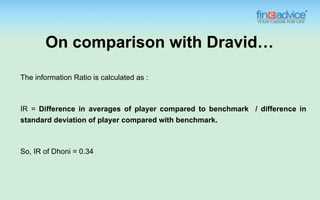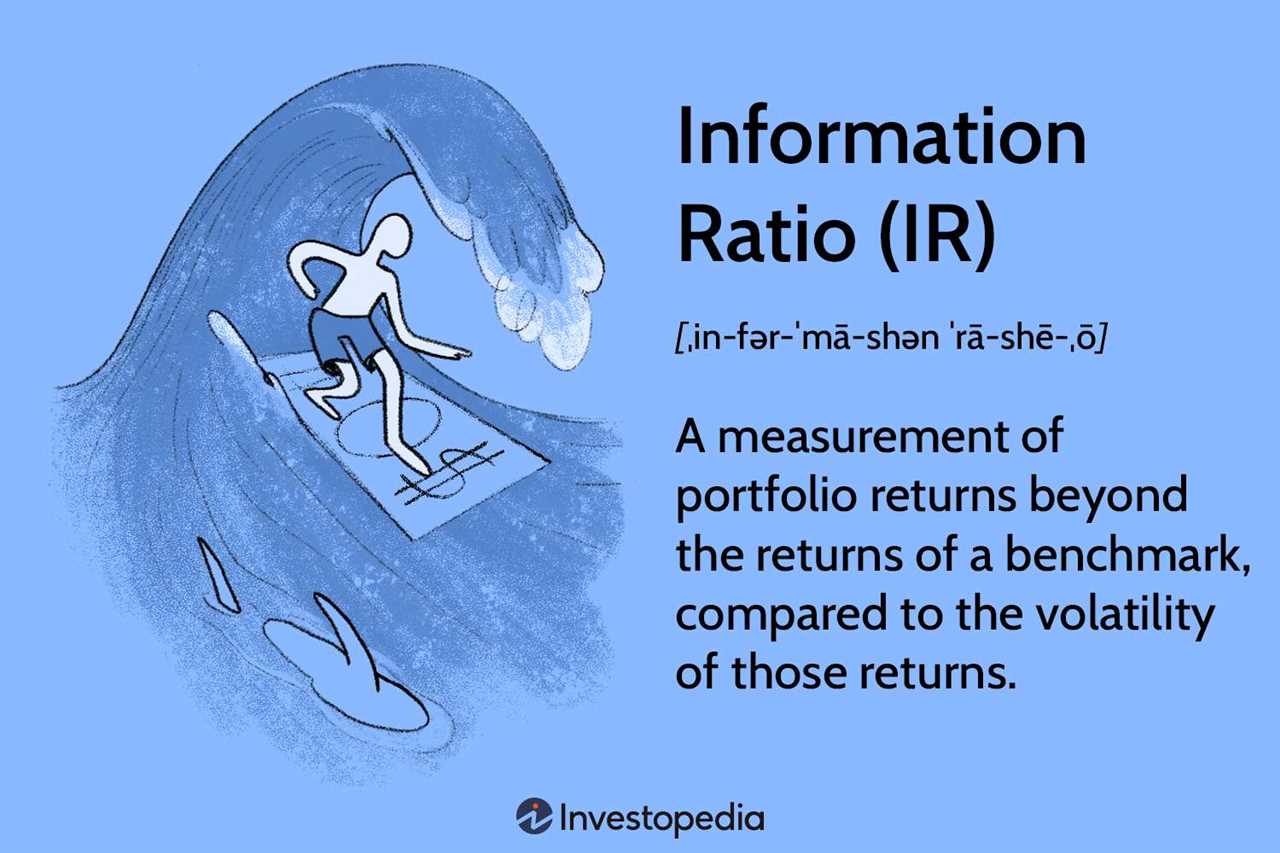Information Ratio (IR) Definition Formula
The Information Ratio (IR) is a financial ratio that measures the risk-adjusted return of an investment or portfolio compared to a benchmark. It is used by investors and portfolio managers to evaluate the performance of their investments and determine whether they are generating excess returns.
The formula for calculating the Information Ratio is as follows:
Where:
- IR is the Information Ratio
- Rp is the average return of the investment or portfolio
- Rb is the average return of the benchmark
- σp is the standard deviation of the investment or portfolio
The Information Ratio is a measure of the excess return generated by an investment or portfolio per unit of risk taken. A higher Information Ratio indicates that the investment or portfolio is generating higher returns relative to its risk compared to the benchmark.
Interpreting the Information Ratio
A positive Information Ratio indicates that the investment or portfolio has outperformed the benchmark on a risk-adjusted basis. A negative Information Ratio indicates underperformance. The higher the Information Ratio, the better the performance relative to the benchmark.
Overall, the Information Ratio is a useful tool for investors and portfolio managers to assess the performance of their investments and make informed decisions about their portfolios.
What is Information Ratio?
The Information Ratio (IR) is a financial ratio that measures the risk-adjusted return of an investment or portfolio compared to a benchmark. It is used by investors and portfolio managers to evaluate the performance of their investments and determine if they are generating excess returns.
The Information Ratio takes into account both the return and the volatility of an investment. It provides a measure of how much value an investment manager is adding to a portfolio relative to the benchmark. A higher Information Ratio indicates that the investment manager is generating higher returns for the same level of risk.
Importance of Information Ratio
The Information Ratio is an important metric for investors and portfolio managers because it helps them assess the skill and performance of an investment manager. It allows them to compare different investment strategies and determine which ones are generating the highest risk-adjusted returns.
By calculating the Information Ratio, investors can identify investment managers who consistently outperform the benchmark and have a higher probability of generating positive returns in the future. It also helps them identify investment managers who may be taking excessive risks or not adding value to the portfolio.
Calculating Information Ratio
The Information Ratio is calculated by dividing the excess return of an investment or portfolio by its tracking error. The excess return is the difference between the actual return of the investment or portfolio and the return of the benchmark. The tracking error measures the volatility or risk of the investment or portfolio relative to the benchmark.
The formula for calculating the Information Ratio is as follows:
A higher Information Ratio indicates that the investment or portfolio is generating higher returns for the same level of risk. A lower Information Ratio indicates that the investment or portfolio is underperforming the benchmark or taking on excessive risk.
How is Information Ratio Calculated?

The Information Ratio (IR) is a financial ratio that measures the risk-adjusted return of an investment or portfolio compared to a benchmark index. It is used by investors and portfolio managers to evaluate the performance of their investments and determine whether they are generating excess returns.
The formula for calculating the Information Ratio is as follows:
Where:
- Portfolio Return is the return generated by the investment or portfolio over a specific period of time.
- Benchmark Return is the return generated by the benchmark index over the same period of time.
- Tracking Error is a measure of the volatility or risk of the investment or portfolio compared to the benchmark index.
The Information Ratio is calculated by subtracting the benchmark return from the portfolio return and then dividing the result by the tracking error. The tracking error is a measure of the variability of the portfolio’s returns compared to the benchmark index. A higher tracking error indicates a higher level of risk.
The Information Ratio provides a measure of the risk-adjusted return of an investment or portfolio. A positive Information Ratio indicates that the investment or portfolio has generated excess returns compared to the benchmark index, while a negative Information Ratio indicates underperformance.
Investors and portfolio managers use the Information Ratio to compare different investments or portfolios and determine which ones are generating the highest risk-adjusted returns. It helps them identify investments that have consistently outperformed the benchmark index and may be worth considering for inclusion in their portfolios.
It is important to note that the Information Ratio is just one of many financial ratios used to evaluate investment performance. It should be used in conjunction with other metrics and analysis to make informed investment decisions.
Sharpe Ratio

The Sharpe Ratio is a financial ratio that measures the risk-adjusted return of an investment compared to the risk-free rate of return. It was developed by Nobel laureate William F. Sharpe and is widely used by investors to evaluate the performance of investment portfolios.
The Sharpe Ratio takes into account both the return and the volatility of an investment. It is calculated by subtracting the risk-free rate of return from the average return of the investment, and then dividing the result by the standard deviation of the investment’s returns. The formula for the Sharpe Ratio is as follows:
One of the key advantages of the Sharpe Ratio is that it allows investors to compare the risk-adjusted returns of different investments. By calculating the Sharpe Ratio for multiple investments, investors can determine which investment offers the best risk-adjusted return and make more informed investment decisions.
What is Sharpe Ratio?
The Sharpe Ratio is a financial ratio that measures the risk-adjusted return of an investment compared to the risk-free rate of return. It was developed by Nobel laureate William F. Sharpe and is widely used by investors and analysts to evaluate the performance of investment portfolios.
The Sharpe Ratio takes into account both the return and the risk of an investment. It allows investors to compare the returns of different investments while considering the level of risk involved. The higher the Sharpe Ratio, the better the risk-adjusted return of the investment.
The formula for calculating the Sharpe Ratio is as follows:
The numerator of the formula represents the excess return of the investment above the risk-free rate, while the denominator represents the volatility or risk of the investment. By dividing the excess return by the volatility, the Sharpe Ratio provides a measure of the return per unit of risk.
A higher Sharpe Ratio indicates that an investment has generated a higher return for the level of risk taken. It is important to note that the Sharpe Ratio is not an absolute measure of investment performance, but rather a relative measure that allows for comparisons between different investments.
Investors can use the Sharpe Ratio to evaluate the performance of a portfolio or to compare the performance of different investment options. It helps investors to make informed decisions by considering both the return and the risk of an investment.

Emily Bibb simplifies finance through bestselling books and articles, bridging complex concepts for everyday understanding. Engaging audiences via social media, she shares insights for financial success. Active in seminars and philanthropy, Bibb aims to create a more financially informed society, driven by her passion for empowering others.
